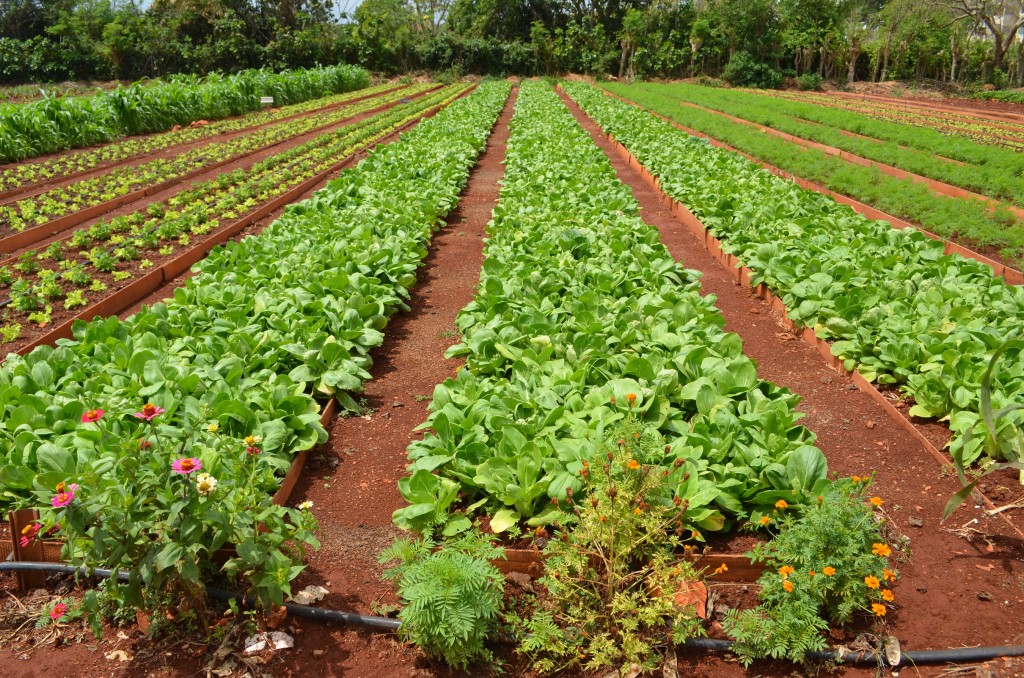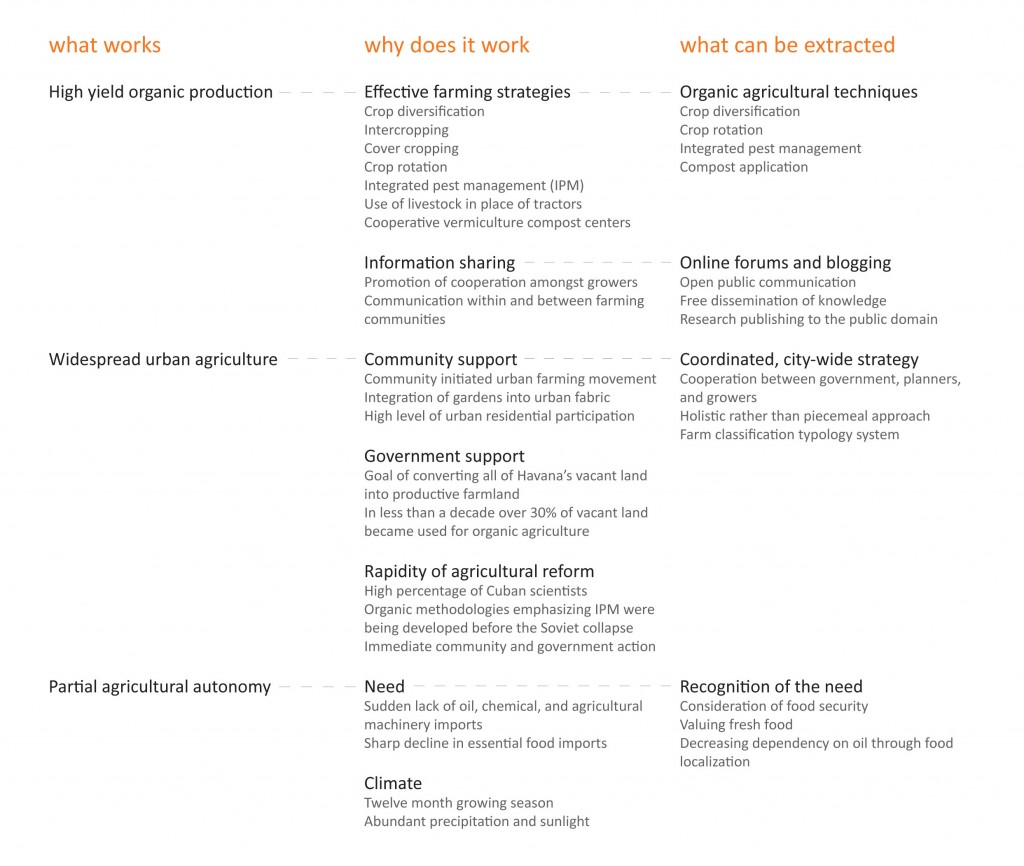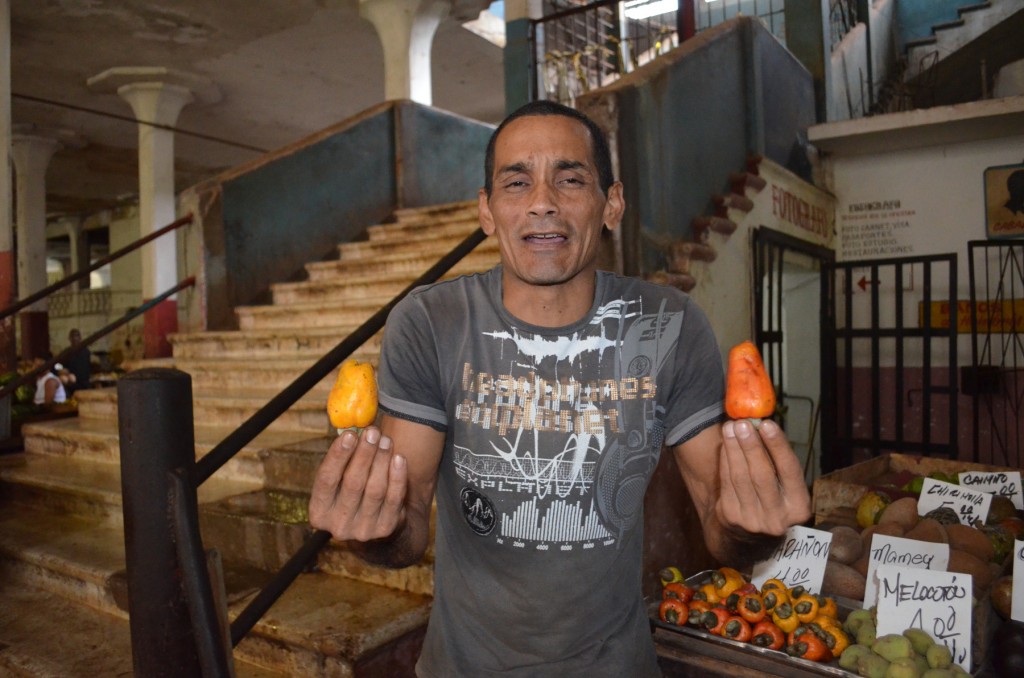learning from Cuba

Cuban agricultural field || photo by Karen Jacobson
Let’s face it, we’re all a little obsessed with our own garden. I spend time with my rooftop vegetables like any good gardener and talk to friends about their latest gardening fads and experiments. But what if we stepped back and thought about rooftop agriculture at a larger scale? What if we looked to other cities or even countries to learn from comprehensive urban agricultural strategies? With a global eye on agriculture we can identify which methodologies and technologies from abroad can be extracted, combined and applied to our skyline to further the rooftop agriculture industry.

Cuban food market || photo by Karen Jacobson
In the 1990s, Cuba implemented a national agricultural strategy as a solution to hunger. When the formerly import-dependent country experienced Soviet import sanctions in the 1990s (compounding the existing U.S. embargo and worsened by allied acts in 1992 and 1996), access to imported oil, farming equipment, agricultural chemicals and food became practically nonexistent. Cubans were forced to curb their oil use by minimizing gas-powered equipment operation (a staple of industrial-scale agriculture) as well as food transportation, refrigeration and storage. These changes particularly impacted the 75% of Cubans living in urban areas,¹ who now had little access to food. Cuba’s agricultural sector was devastated. As a result, the Organic Revolution shifted food production from rural farms to cities in order to better serve population centers.
Cuba’s reorientation towards small, organic and semi-organic urban farms began with community initiative. The government followed suit by establishing an Urban Agriculture Department within the Ministry of Agriculture, with a goal of converting all of Havana’s vacant land into productive farmland. In less than a decade over 30% of Havana’s vacant urban land became repurposed for organic agriculture, with 8,000 farms and gardens in Havana alone and more than 30,000 Cubans directly engaged in production.²
The most common type of garden in Cuba is the huerto popular, commonly called “popular garden.” These small, residential gardens on state-owned land are cultivated by individuals and community groups in urban areas. Gardens throughout the country range in size from a few square yards to 7.5 acres.³ Larger gardens are commonly divided into smaller plots and can be cultivated by coordinated groups of households reaching upwards of 70 people, generally men.

Organically grown carrots || photo by Karen Jacobson
Out of necessity, the Organic Revolution emphasized high-yield production without the use of chemical inputs or agricultural machinery. To clarify, the use of the word “organic” in this context does not refer to an organic certification (as it does in other countries like the U.S.), but rather the practice of chemical-free production. Cuba’s primary organic farming and gardening practices include the widespread use of intercropping (growing multiple crops together in a single area), integrated pest management (IPM, managing insect pest populations without chemicals), supplementing with organic amendments (compost, vermicomost, manure), the utilization of livestock and the promotion of cooperation and information sharing through horticultural clubs. Cuban scientists also contributed to the advancement of organic practices, particularly within the field of IPM. Many of these farming practices were actually used in Cuba before industrial agriculture too root, so the Organic Revolution caused somewhat of a “back to basics” approach to farming.
Up on the roof, mechanized equipment is impractical and chemicals are generally avoided. These similarities set the stage for considering which Cuban agricultural techniques could be applied to our skyline to maximize yields in rooftop row farms and raised beds. The chart below describes what works in the Cuban agricultural sector, why it works and what techniques can be extracted and applied to rooftop agriculture. Here are the CliffsNotes, for your ruminating pleasure:
1| Organic agricultural techniques: Promote chemical-free production strategies that maximize species diversity, soil health and pest control.
2| Online forums and blogging: Share rooftop agricultural knowledge through online forums and publicly accessible research.
3| Coordinated, city-wide strategy: Forward infrastructure and policy through coordinated efforts of government, city planners and growers.
4| Recognition of the need: Consider rooftop agriculture’s potential in providing fresh food to communities in need and recognize the importance of food localization.

Cuban agriculture analysis + application to rooftop agriculture || by Lauren Mandel
¹ Central Intelligence Agency. 2009. The World Factbook: Cuba. Accessed 15 January 2010. <www.cia.gov/library/publications/the-world-factbook/geos/cu.html>.
² Murphy, C. 1999. Cultivating Havana: Urban agriculture and food security in the years of crisis. Institute for Food and Development Report, no. 12.
³ Warwick, Hugh. 1999. Cuba’s organic revolution. The Ecologist, vol. 29, no. 8.
 EAT UP
EAT UP
Hi Lauren, I’m sure you’ve heard about Dietz and Watson expanding in Tacony in a city brokered deal (over $14 mil. taxpayer $$) . 200,000sqft/+4acres of rooftop. Now would be the time to approach them about doing something green on top. D&W had solar panels on their DelCo NJ plant that burned so it would seem they were open to innovation. With all the taxpayer money going into this deal they should be compelled to do give something back to the surrounding community. They’re right on the river so a green roof would be a no-brainer for stormwater mgt. Even if they want their solar panels back a green roof makes them more efficient and decreases long-term maintenance issues.
Larry Shaeffer
larryshaeffer@gmail.com
Hi Larry, thanks so much for this tip! I have a connection to the owner of Dietz and Watson and will look into their vision for their expansion. Rooftop food production at a facility like this seems like a reasonable proposed program, particularly in conjunction with a larger extensive green roof for stormwater management, as you suggest.
great to hear you have an all important connection to “Momma Dietz”:-) BTW: I’m developing a proto-type of a very low-cost aluminum planter for rooftop gardening. Over the years I’ve gone thru too many wood planters. I’ve always used recycled (dumpster dived) wood and even old dresser drawers but they all fall apart too quickly from the stresses of rooftop gardening. I wanted something that was lightweight but not plastic but most aluminum planters are very pricey. I found a rolled aluminum stock used for roof flashing and home siding that will bring the price point way down for each planter. My initial desgn has lots of longitudal bends/folds to provide support for the long planter. Its also has an adjustable leg on one end so the planter can be cantilevered off the typical rowhouse roof parapet on the loadbearing perimeter walls. RIght now I’m trying to incorporate some kind of fixture for irrigation-again I don’t want to go with plastic so I’m trying various cast metal and rubber combinations. With the irrigation, my goal is that the planters could be connected in-series then at either end to an outside faucet or water storage barrel. I’ll let you know when the planter is ready for prime time. Larry Shaeffer
Larry, sounds great! We’re always looking for cool new products to feature on the EAT UP Facebook page. Let me know once you snap some photos of the planter.
Pingback: Urban agriculture | GreenFloss